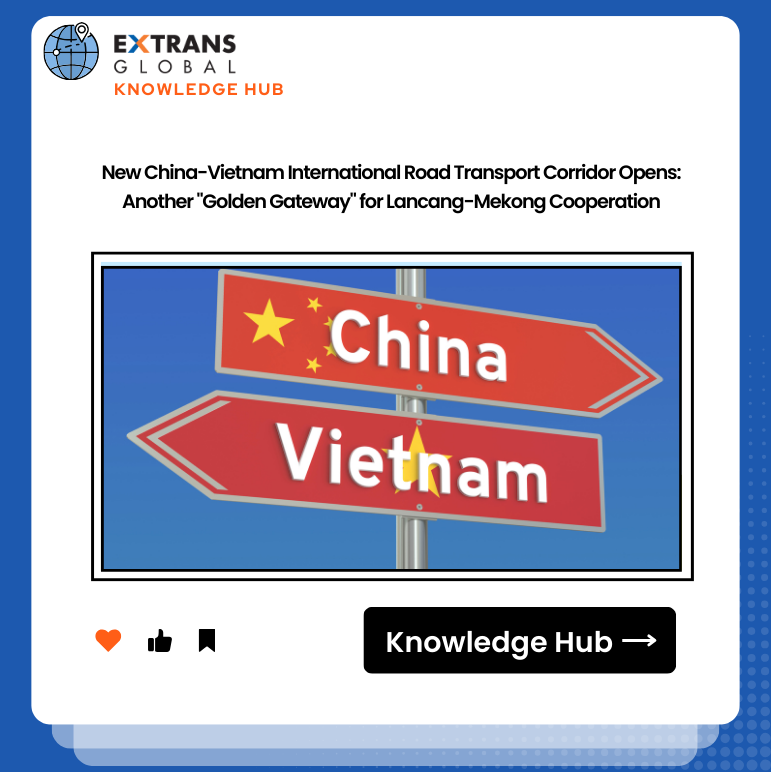New China-Vietnam International Road Transport Corridor Opens: Another "Golden Gateway" for Lancang-Mekong Cooperation

Introduction: On May 14, 2025, the new international road transport corridor connecting China to Hanoi, Vietnam, was officially launched, marking a significant breakthrough in the cross-border logistics network of the Greater Mekong Subregion (GMS). On the same day, 18 trucks and 2 passenger vehicles carrying electronic components, fresh agricultural products, daily necessities, and other goods departed simultaneously from Nanning, Guangxi, and Kunming, Yunnan, in China, reaching deep into Vietnam for the first time under the CBTA (Cross-Border Transport Agreement) framework. This milestone event not only optimizes the China-Vietnam cross-border logistics system but also injects new vitality into regional economic integration. The specific highlights include:
1. Institutional Breakthrough: CBTA Resolves Cross-Border Logistics Challenges
- Broad Coverage: The CBTA agreement covers six countries—China, Vietnam, Laos, Myanmar, Thailand, and Cambodia—allowing passenger and cargo vehicles to travel freely under the GMS framework, significantly reducing traditional administrative barriers in cross-border transport.
- Streamlined Procedures: Vehicles no longer need frequent license plate changes or repeated declarations, enabling "single-document clearance." Collaborative operations between customs and border inspection agencies have reduced clearance times by over 50%.
- Cost Reduction: Enterprises save on intermediate costs such as vehicle clearance, transshipment, and agency fees, with transport efficiency increasing by more than 30%.
2.Dual-Route Layout: Building an Efficient "Door-to-Door" Logistics Network
a.Nanning–Hanoi Route:
- Route: Nanning Comprehensive Bonded Zone → Friendship Pass Port → Lang Son (Vietnam) → Bac Giang → Bac Ninh → Hanoi (total distance: ~400 km, duration: 2 days).
- Key Advantage: Direct access to northern Vietnam's industrial belt, serving high-value-added industries like electronics and machinery components. Transport efficiency improves by 40% compared to traditional models, facilitating faster entry of "Made in China" products into Southeast Asian markets.
b.Kunming–Hanoi Route:
- Route: Kunming Comprehensive Bonded Zone → Hekou Port → Lao Cai (Vietnam) → Yen Bai → Viet Tri → Hanoi (total distance: ~700 km, duration: 2 days).
- Strategic Significance: Strengthens trade channels for resources and agricultural products between Southwest China and north-central Vietnam, extending the "New Western Land-Sea Corridor" southward and linking it to RCEP regional supply chains.
c.Economic Benefits:
- Time Savings: Saves at least 1 day per trip compared to traditional segmented transport.
- Cost Optimization: Reduces transport costs by 800–1,000 RMB per truck, with annual savings exceeding millions for cross-border logistics companies.
3.Trade Dividends: Supply Chain Upgrades and Market Expansion
- Industrial Synergy: Time-sensitive goods like electronic components and precision equipment achieve "door-to-door" delivery, fostering deeper integration in China-Vietnam manufacturing and enabling a new division of labor: "Chinese R&D + Vietnamese assembly."
- Agricultural Exchange: Fresh vegetables from Yunnan and Guangxi reach Vietnam within 24 hours, while Vietnamese tropical fruits and aquatic products enjoy similarly improved transport efficiency, supporting the joint development of a "regional agricultural distribution center."
- Market Growth: The new corridor covers Hanoi and its surrounding economic zones (accounting for over 30% of Vietnam's GDP), providing a springboard for Chinese goods to enter core Southeast Asian markets.
4.People-to-People Ties: From "Smooth Flow of Goods" to "Smooth Flow of People"
- Cultural and Tourism Integration: The cross-border passenger route facilitates tourism, business travel, and cultural exchanges, with an expected increase of over 100,000 two-way passengers within the year.
- Institutional Safeguards: Joint efforts by Chinese and Vietnamese transport, customs, and border authorities ensure smooth clearance processes, with trials of "one-stop" border inspection models and 24/7 emergency hotlines for safety and efficiency.
- Strategic Timing: Coinciding with the 75th anniversary of China-Vietnam diplomatic relations and the "China-Vietnam Year of People-to-People Exchange" in 2025, the corridor exemplifies synergy between "hard connectivity" (infrastructure) and "soft connectivity" (institutional cooperation).
5.Regional Vision: Creating a "Golden Transport Network" for Lancang-Mekong Cooperation
- Demonstration Effect: The corridor sets a replicable model for GMS countries in cross-border transport rules, with plans to expand to Laos and Thailand, forming a logistics network across the Indochina Peninsula.
- Policy Synergy: Combined with the Regional Comprehensive Economic Partnership (RCEP), it further reduces regional trade costs, upgrading Lancang-Mekong cooperation from "transport connectivity" to "economic integration."
Conclusion: The new China-Vietnam international road transport corridor is not merely an extension of logistics networks but a milestone in regional integration. Through institutional innovation (CBTA), route optimization (dual routes), and cross-departmental collaboration, China and Vietnam have provided a replicable "Chinese solution" for building an "efficient, inclusive, and sustainable" cross-border economic corridor in the Lancang-Mekong region, injecting new momentum into global South-South cooperation.

top



